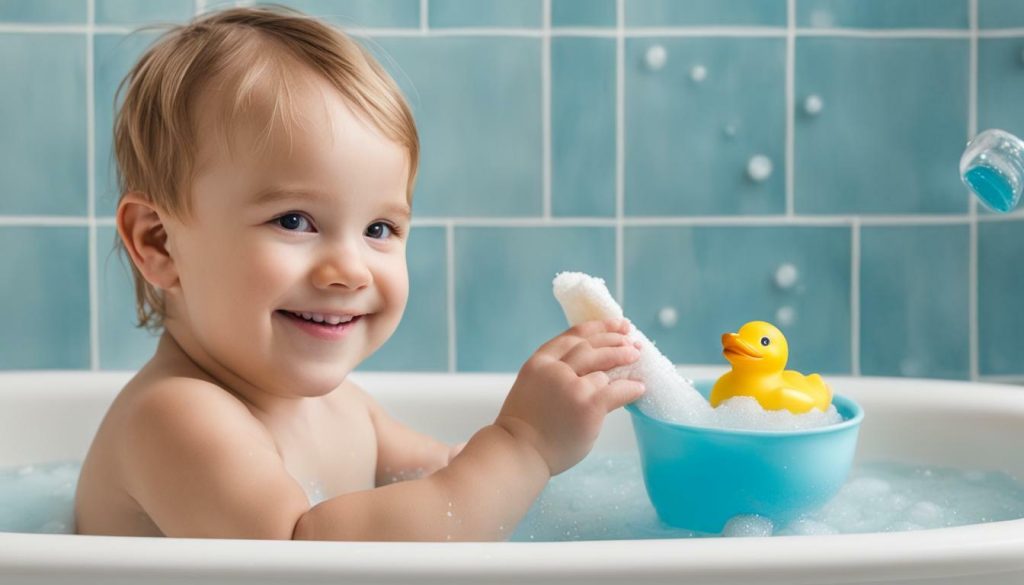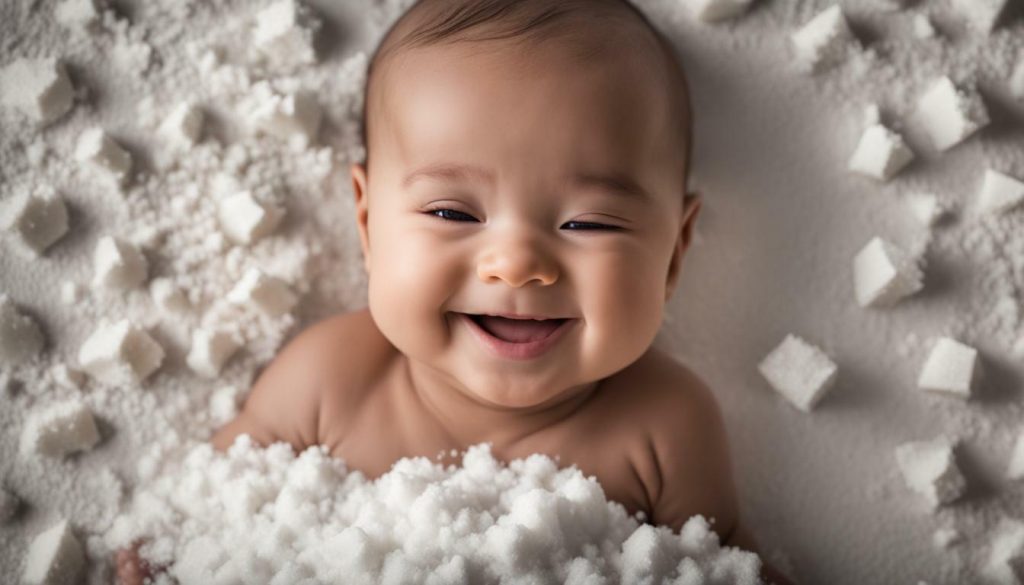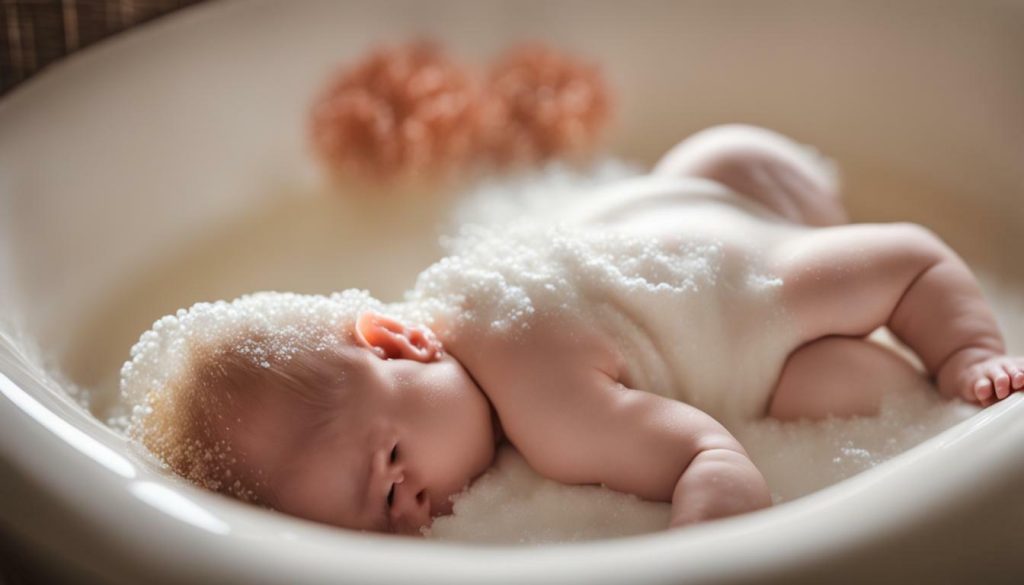
Diaper rash is a common issue that can cause discomfort for your baby, but a baking soda bath can provide gentle relief. When the skin is irritated by the moisture from urine and feces, it can lead to redness, swelling, and even painful blisters. To prevent diaper rash, it’s important to change diapers frequently and use water-based wipes or warm water for cleaning.
If a diaper rash does occur, applying a barrier cream with zinc oxide at each diaper change can help create a protective barrier against moisture. Additionally, giving your baby some air time without a diaper can allow the irritated area to dry out and promote healing.
A baking soda bath can also be an effective natural remedy for diaper rash. Baking soda has anti-inflammatory properties that can help soothe itching and reduce inflammation. It can also balance pH levels and neutralize odors caused by diaper rash.
To make a baking soda bath for infants, add 2 tablespoons of baking soda to warm bath water and let your baby soak for 5-10 minutes, once or twice a day. For older infants and toddlers, use 4 tablespoons of baking soda in warm bath water and allow them to soak for 10 minutes, once or twice a day.
- A baking soda bath can provide gentle relief for diaper rash in babies.
- Diaper rash can be prevented by changing diapers frequently, using water-based wipes or warm water for cleaning, and using a barrier cream with zinc oxide.
- Giving your baby some diaper-free time can help the irritated area dry out and heal.
- A baking soda bath can soothe itching, reduce inflammation, balance pH levels, and neutralize odors caused by diaper rash.
- Seek medical advice if a diaper rash doesn’t improve with home remedies or if there are signs of infection.
Understanding Diaper Rash and Prevention Tips
Diaper rash occurs when the skin is irritated by the moisture from urine and feces, but there are steps you can take to prevent it. Keeping your baby’s bottom clean and dry is crucial in ensuring their comfort and preventing diaper rash. Here are some tips to help you prevent diaper rash:
- Change diapers frequently: Regularly changing your baby’s diaper can help minimize their exposure to moisture and reduce the risk of diaper rash.
- Use water-based wipes or warm water: Avoid using wipes that contain alcohol or harsh chemicals as they can further irritate your baby’s sensitive skin. Instead, opt for water-based wipes or simply use warm water and a soft cloth for cleaning.
- Apply barrier cream: A barrier cream with zinc oxide can help create a protective layer on your baby’s skin, preventing direct contact with urine and feces. Remember to apply the cream at each diaper change.
- Give your baby some air time: Allowing your baby to have some diaper-free time can help the irritated area dry out and heal. Lay a towel on the floor and let your little one explore and play while their bottom is exposed to air.
Taking these preventive measures can significantly reduce the chances of diaper rash. However, if your baby still develops a rash, there are natural remedies that can provide relief, such as using a baking soda bath.

Baking soda is known for its soothing and healing properties. When added to bath water, it can help alleviate the discomfort caused by diaper rash. Baking soda has anti-inflammatory properties that can reduce redness, itching, and inflammation. It can also balance the pH levels of your baby’s skin, helping to restore its natural barrier and promote healing.
Using a baking soda bath as a natural remedy for diaper rash is simple. For infants, add 2 tablespoons of baking soda to warm bath water and let your baby soak their bottom for 5-10 minutes. For older infants and toddlers, use 4 tablespoons of baking soda in the bath water and increase the soaking time to 10 minutes. You can do this once or twice a day, depending on the severity of the diaper rash.
However, it’s important to note that while baking soda can be effective in providing relief for diaper rash, it’s essential to seek medical advice if the rash doesn’t improve with home remedies or if there are signs of infection. Your baby’s health and well-being should always be prioritized, and a healthcare professional can provide the necessary guidance and treatment if needed.
| Summary: |
|---|
| Diaper rash occurs due to the skin’s irritation by moisture from urine and feces. To prevent it, change diapers frequently, use water-based wipes or warm water, apply barrier cream, and give your baby some diaper-free time. If a diaper rash does occur, a baking soda bath can provide relief. Baking soda has anti-inflammatory properties and can balance the skin’s pH levels. However, seek medical advice if the rash persists or shows signs of infection. |
Using Barrier Cream and Air Time for Diaper Rash Prevention
Applying a barrier cream with zinc oxide at each diaper change can help protect your baby’s skin and prevent diaper rash. The zinc oxide creates a barrier between the baby’s delicate skin and the moisture from urine and feces, reducing the risk of irritation and rash development. Look for a cream specifically formulated for diaper rash, and apply a generous amount to the entire diaper area.
In addition to using barrier cream, giving your baby some air time without a diaper can help the irritated area dry out. Exposing the skin to fresh air can promote healing and prevent moisture buildup, which can worsen diaper rash. Find a safe and comfortable spot, such as a towel or waterproof mat, and let your baby have some naked time for a few minutes throughout the day.
Barrier Cream Application Instructions
1. Gently clean your baby’s diaper area with warm water or a water-based wipe.
2. Pat the area dry with a soft towel or allow it to air dry.
3. Squeeze a small amount of barrier cream onto your fingertips.
4. Apply a thick, even layer of cream to the entire diaper area, paying extra attention to any red or irritated areas.
5. Secure a clean diaper on your baby.
Remember to change your baby’s diaper frequently, especially when wet or soiled, to reduce the risk of diaper rash. If your baby does develop a diaper rash, using a barrier cream with zinc oxide and providing air time can help alleviate the discomfort and promote healing.
| Benefits of Using Barrier Cream and Air Time for Diaper Rash Prevention |
|---|
| Protection: Barrier creams create a protective layer that shields your baby’s skin from moisture and irritants. |
| Healing: When applied consistently, barrier creams with zinc oxide can help soothe and heal existing diaper rash. |
| Dryness: Allowing your baby some naked time without a diaper promotes airflow and helps keep the diaper area dry, reducing the risk of diaper rash. |
| Prevention: Using barrier cream and providing air time are effective preventive measures that can minimize the occurrence of diaper rash. |

Introducing Baking Soda as a Remedy for Diaper Rash
Baking soda is a gentle and effective natural remedy for diaper rash, and you can easily prepare a soothing baking soda bath for your baby. Diaper rash is a common issue that occurs when the skin is irritated by the moisture from urine and feces. To prevent diaper rash, it’s important to change diapers frequently and use water-based wipes or warm water for cleaning.
If a diaper rash does occur, applying a barrier cream with zinc oxide at each diaper change can help create a protective layer between the skin and the wetness. Additionally, giving your baby some air time without a diaper can help the irritated area dry out and promote healing.
A baking soda bath can also be effective in treating stubborn diaper rash. For infants, add 2 tablespoons of baking soda to warm bath water and let the baby’s bottom soak for 5-10 minutes, once or twice a day. For older infants and toddlers, use 4 tablespoons of baking soda and have them soak for 10 minutes once or twice a day. Baking soda has anti-inflammatory properties that can help relieve itching and inflammation caused by diaper rash. It can also balance pH levels and remove odors, leaving your baby feeling more comfortable and calm.

Remember, while baking soda can provide relief for most cases of diaper rash, it’s important to seek medical advice if the rash doesn’t improve with home remedies or if there are signs of infection. A healthcare professional can provide further guidance and recommend additional treatments if necessary.
| Baking Soda Bath Recipe: |
|---|
| – For infants: Add 2 tablespoons of baking soda to warm bath water and let the baby’s bottom soak for 5-10 minutes, once or twice a day. |
| – For older infants and toddlers: Use 4 tablespoons of baking soda and have them soak for 10 minutes once or twice a day. |
A baking soda bath can provide gentle and soothing relief for your baby’s diaper rash.
By incorporating a baking soda bath into your baby’s diaper rash care routine, you can help alleviate discomfort and promote healing. Remember to practice regular diaper changes, use gentle cleaning methods, and consult a healthcare professional if needed. Your baby’s comfort and well-being are always a top priority.
Baking Soda Bath for Infants
For infants with diaper rash, you can add 2 tablespoons of baking soda to warm bath water and soak your baby’s bottom for 5-10 minutes, once or twice a day. This baking soda bath provides gentle relief and helps soothe your baby’s irritated skin.
Baking soda has anti-inflammatory properties that can reduce itching and inflammation caused by diaper rash. It also helps balance the pH levels of the skin, creating an environment less conducive to the growth of bacteria and fungi. Additionally, baking soda can remove odors, leaving your baby’s skin fresh and clean.
When preparing the baking soda bath, make sure the water is comfortably warm, but not too hot. Dissolve the baking soda thoroughly in the water before placing your baby in the bath. Use a soft washcloth to gently clean your baby’s bottom while they soak. After the bath, pat your baby’s skin dry with a soft towel and apply a barrier cream with zinc oxide to protect the skin from moisture.
| Baking Soda Bath Instructions for Infants |
|---|
| Fill a baby bathtub or basin with warm water. |
| Add 2 tablespoons of baking soda to the water. Stir well to dissolve. |
| Gently place your baby in the bath and allow them to soak for 5-10 minutes. |
| Use a soft washcloth to clean your baby’s bottom while they soak. |
| Remove your baby from the bath and pat their skin dry with a soft towel. |
| Apply a barrier cream with zinc oxide to protect the skin. |
Remember, while a baking soda bath can be helpful in relieving diaper rash, it’s important to seek medical advice if the rash doesn’t improve with home remedies or if there are signs of infection. Your baby’s pediatrician can provide further guidance and treatment options if necessary.
Baking Soda Bath for Older Infants and Toddlers
If your baby is older or a toddler, you can increase the amount of baking soda to 4 tablespoons and have them soak in the warm bath water for 10 minutes, once or twice a day. This increased concentration of baking soda will help to effectively soothe and heal their stubborn diaper rash.

The baking soda bath works by balancing the pH levels of your baby’s skin, reducing inflammation and relieving itching caused by the rash. Additionally, the baking soda helps to neutralize odors associated with diaper rash, leaving your baby feeling fresh and comfortable.
During the bath, make sure your baby’s bottom is fully submerged in the warm water and gently swish the water around to ensure that the baking soda is evenly distributed. After the bath, pat your baby’s skin dry with a soft towel and apply a diaper cream or ointment to further protect and soothe the affected area.
“The baking soda bath has been a game-changer for my toddler’s diaper rash. It provides immediate relief and helps to speed up the healing process. I highly recommend giving it a try!” – Sarah, mom of two
The Benefits of Baking Soda for Diaper Rash
Using baking soda for diaper rash offers several benefits, such as soothing inflammation and balancing pH levels. When your baby experiences diaper rash, their delicate skin becomes irritated due to moisture from urine and feces. While frequent diaper changes and proper cleaning with water-based wipes or warm water can help prevent diaper rash, sometimes it can’t be avoided. That’s when baking soda comes in handy.
Baking soda has anti-inflammatory properties that can provide gentle relief for your baby’s diaper rash. It helps soothe itching and reduce inflammation, making your little one more comfortable. Additionally, baking soda can balance pH levels, which can be beneficial in restoring the skin’s natural acidity and reducing irritation.
To make a baking soda bath for your baby, simply add 2 tablespoons of baking soda to warm bath water, ensuring it dissolves completely. Let your infant soak their bottom in the mixture for 5-10 minutes, once or twice a day. For older infants and toddlers, you can increase the amount of baking soda to 4 tablespoons and extend the soaking time to 10 minutes. Remember, consistency is key to seeing results.
| Benefits of Baking Soda for Diaper Rash: |
|---|
| Soothes itching and inflammation |
| Helps balance pH levels |
| Relieves discomfort caused by diaper rash |
While baking soda can be a helpful remedy for diaper rash, it’s important to seek medical advice if the rash doesn’t improve with home remedies or if there are signs of infection. Your child’s pediatrician will be able to provide further guidance and recommend any additional treatments if necessary.
Using baking soda as a natural remedy for diaper rash can be a gentle and effective way to provide relief for your baby. Remember to always prioritize prevention by changing diapers frequently, using a barrier cream with zinc oxide, and giving your little one some diaper-free time to allow the irritated area to heal. By being attentive and proactive, you can help keep your baby’s skin healthy and happy.

While using natural remedies like baking soda can be effective for diaper rash, it’s important to seek medical advice if the rash persists or shows signs of infection. As a parent, it’s normal to feel concerned about your baby’s discomfort and want to try home remedies to provide relief. However, there are certain situations where medical attention is necessary to ensure your baby’s well-being.
If your baby’s diaper rash doesn’t improve within a few days of using baking soda baths and other home remedies, it may be time to consult a healthcare professional. They can assess the severity of the rash and recommend appropriate treatment options. Additionally, if you notice any signs of infection such as pus-filled blisters, increased redness, swelling, or a high fever, it’s important to seek medical attention immediately.
Remember, healthcare professionals have the expertise to diagnose and treat diaper rash effectively. They may prescribe medicated creams or ointments to address the underlying cause of the rash and provide faster relief for your baby. Seeking medical advice is particularly crucial if your baby has any pre-existing conditions or a weakened immune system.
Summary
- Seek medical advice if the rash persists or shows signs of infection.
- If the diaper rash doesn’t improve within a few days, consult a healthcare professional.
- Look out for signs of infection such as pus-filled blisters, increased redness, swelling, or a high fever.
- Healthcare professionals can diagnose and treat diaper rash effectively, providing faster relief.
- Medical attention is especially important for babies with pre-existing conditions or weakened immune systems.

| Signs to Seek Medical Advice | When to Consult a Healthcare Professional |
|---|---|
| Persistent diaper rash | If the rash doesn’t improve within a few days of using home remedies. |
| Signs of infection | If you notice pus-filled blisters, increased redness, swelling, or a high fever. |
| Pre-existing conditions | If your baby has any pre-existing medical conditions or a weakened immune system. |
Conclusion
A baking soda bath can be a gentle and effective natural remedy for diaper rash, providing relief and comfort for your baby. Diaper rash is a common issue that can cause discomfort and irritation for infants and toddlers. It occurs when the skin is irritated by the moisture from urine and feces, leading to redness, inflammation, and sometimes even open sores.
To prevent diaper rash, it’s important to change diapers frequently and use water-based wipes or warm water for cleaning. Applying a barrier cream with zinc oxide at each diaper change can also help protect the skin. Additionally, giving your baby some air time without a diaper can help the irritated area dry out and promote healing.
A baking soda bath can provide soothing relief for diaper rash. Baking soda has anti-inflammatory properties that can help reduce itching and inflammation. It can also balance pH levels and remove odors, leaving your baby’s skin feeling fresh and clean.
For infants, add 2 tablespoons of baking soda to warm bath water and soak the baby’s bottom for 5-10 minutes, once or twice a day. For older infants and toddlers, add 4 tablespoons of baking soda to warm bath water and have them soak for 10 minutes once or twice a day. Remember to always supervise your baby during bath time and ensure the water temperature is safe and comfortable.
While a baking soda bath can be an effective natural remedy for diaper rash, it’s important to seek medical advice if the rash doesn’t improve with home remedies or if there are signs of infection. Your pediatrician can provide guidance and recommend additional treatments if necessary.

| Baking Soda Bath for Infants | Baking Soda Bath for Older Infants and Toddlers |
|---|---|
| Add 2 tablespoons of baking soda to warm bath water | Add 4 tablespoons of baking soda to warm bath water |
| Soak the baby’s bottom for 5-10 minutes, once or twice a day | Have them soak for 10 minutes, once or twice a day |
“A baking soda bath can provide gentle relief for your baby’s diaper rash, soothing their sensitive skin and reducing inflammation.” – Dr. Emma Thompson, Pediatrician
Conclusion
A baking soda bath can be a gentle and effective natural remedy for diaper rash, providing relief and comfort for your baby. By following the prevention tips and seeking medical advice when needed, you can help keep your baby’s skin healthy and rash-free.
Diaper rash is a common issue that occurs when the skin is irritated by the moisture from urine and feces. To prevent diaper rash, it’s important to change diapers frequently and use water-based wipes or warm water for cleaning.
If a diaper rash does occur, applying a barrier cream with zinc oxide at each diaper change can help. Additionally, giving your baby some air time without a diaper can help the irritated area dry out.
A baking soda bath can also be effective in treating stubborn diaper rash. For infants, add 2 tablespoons of baking soda to warm bath water and soak the baby’s bottom for 5-10 minutes, once or twice a day. For older infants and toddlers, add 4 tablespoons of baking soda to warm bath water and have them soak for 10 minutes once or twice a day.
Baking soda has anti-inflammatory properties and can help relieve itching and inflammation caused by diaper rash. It can also balance pH levels and remove odors. However, it’s important to seek medical advice if a diaper rash doesn’t improve with home remedies or if there are signs of infection.
FAQ
How can baking soda baths provide relief for diaper rash?
Baking soda has anti-inflammatory properties that can help relieve itching and inflammation caused by diaper rash. It can also balance pH levels and remove odors.
What is diaper rash and how can I prevent it?
Diaper rash is a common issue that occurs when the skin is irritated by the moisture from urine and feces. To prevent diaper rash, it’s important to change diapers frequently and use water-based wipes or warm water for cleaning. Applying a barrier cream with zinc oxide at each diaper change can also help prevent diaper rash.
How do I make a baking soda bath for my baby?
For infants, add 2 tablespoons of baking soda to warm bath water and soak the baby’s bottom for 5-10 minutes, once or twice a day. For older infants and toddlers, add 4 tablespoons of baking soda to warm bath water and have them soak for 10 minutes once or twice a day.
When should I seek medical advice for diaper rash?
It’s important to seek medical advice if a diaper rash doesn’t improve with home remedies or if there are signs of infection. A healthcare professional can provide further guidance and treatment options.




